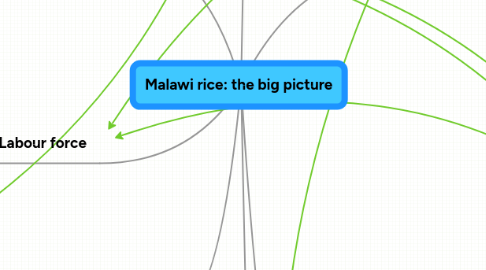
1. 5. Society & Political
1.1. Agricultural policies
1.1.1. Domestic
1.1.2. International
1.2. Political stability: internal & regional
1.2.1. Water scarcity & conflict?
2. 6. Labour force
2.1. Education
2.2. The job 'mix': agriculture, industry, service sector
2.3. Migration
2.4. Dependency ratio
2.4.1. HIV / AIDS
2.4.2. Fertility & mortality
3. 7. Demand & Supply
3.1. Demand
3.1.1. Wealth accumulation and changing diets
3.1.1.1. Asia: trend towards more meat. Impact on land use and calorie per hectare
3.1.1.2. Africa: wealth and shift from maize to rice?
3.2. Supply
3.2.1. Farming efficiency and crop yields
3.2.2. Supply side expenses
3.2.2.1. Import tariffs
3.2.2.2. Fuel & transportation costs
4. 1. Agriculture & Climate
4.1. Global warming
4.1.1. Increased ambient temperature
4.1.2. Increased water temperature
4.2. Agriculture efficiency gains
4.2.1. Fertilisers
4.2.2. Seed varieties & GM crops
4.3. Soil
4.3.1. Land management policies
4.3.2. Property rights & small vs. Large farmers
4.4. Land usage
4.5. Irrigation
5. 2. Population & Health
5.1. Population growth
5.1.1. Per capita rice consumption
5.1.2. Labour force
5.2. HIV/AIDS & other emerging health threats
5.2.1. Cholera
5.2.2. Malaria
5.2.3. Schistomiasis
5.3. Ageing demographic
5.3.1. Double burden of disease
5.3.1.1. Infectious diseases
5.3.1.2. Chronic & degenerative diseases
5.3.2. Demographic & epidemiological transitions
5.4. Urbanisation & changing lifestyles
6. 3. Economy & Trade
6.1. Rice in the global economy
6.1.1. Emerging trends & spatial patterns of rice production
6.1.2. Rice & structural transformation
6.1.3. Asia's green revolution: past achievements & future challenges
6.1.4. Household income dynamics & changes in gender roles in rice farming
6.1.5. Fostering a green revolution in rice: can Africa replicate Asia's experience?
6.1.6. Long-run dynamics of rice consumption, 1960 - 2050
6.1.7. The global rice supply & demand outlook: the need for greater productivity growth to keep rice affordable
6.2. Organisation of rice production, post harvest operations and input efficiency
6.2.1. Economic development, land tenure, and the changing optimum farm size
6.2.2. Rice seed provision & the evolution of seed markets
6.2.3. Fertiliser use, markets & management
6.2.4. Managing irrigation in an environment of water scarcity
6.2.5. Rice pest management: issues and opportunities for efficient post production operations
6.3. The evolving rice market structure
6.3.1. The international rice trade: structure, conduct, and performance
6.3.2. Domestic rice price, trade, and marketing policies
6.4. Technological opportunities and R&D policies
6.4.1. Rice & global climate change
6.4.2. Technological opportunities for developing & deploying improved germplasm for key target traits
6.4.3. Positioning rice research globally: investment arrangements & emerging challenges
7. 4. Poverty & Inequality
7.1. Gini co-efficient
7.2. Small farmers vs large farms
7.3. Education
7.4. Urbanisation
7.5. Impact investment
7.6. Pro-poor
7.6.1. Labour force and farming/ managerial policies
7.6.2. Small farms vs. large scale irrigation schemes?
